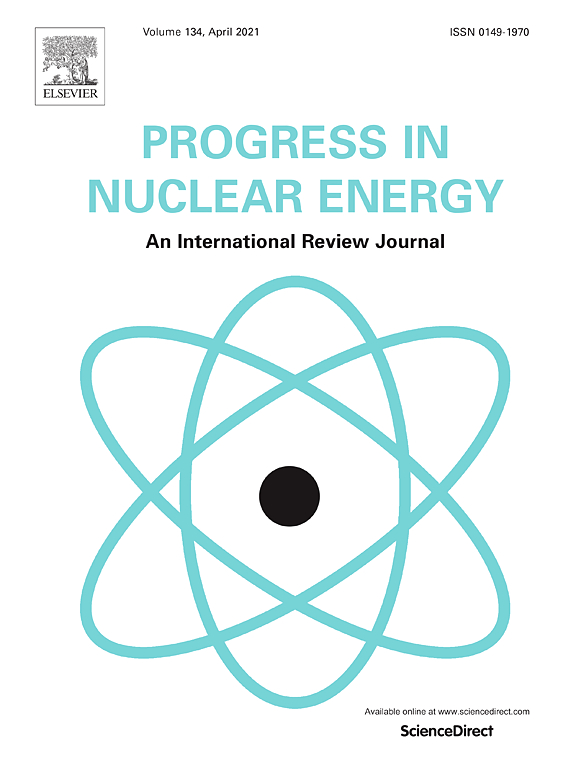HAVE A LOOK AT THE LATEST SCIENTIFIC PAPERS WRITTEN BY THE INSIDER PARTNERS!

New INSIDER publications are now available! The first one is entitled “Radiological characterisation in view of nuclear reactor decommissioning: On-site benchmarking exercise of a biological shield“.
The second article is entitled “Recommendations for the selection of in situ measurement techniques for radiological characterization in nuclear/radiological installations under decommissioning and dismantling processes“.
Both papers have been written as a result of the work undertaken in INSIDER Work Package 5.
The articles are already accessible online and will be published in the July 2021 issue of Progress in Nuclear Energy (Volume 137). Progress in Nuclear Energy is an international review journal covering all aspects of nuclear science and engineering.
Read the full papers:
Radiological characterisation in view of nuclear reactor decommissioning: On-site benchmarking exercise of a biological shield, M. Herranz, S. Boden, P. Völgyesi, R. Idoeta, W. Broeckx, J. Ruiz González, P. Otiougova, A. Klix, L. Sai Leong, Z. Hlavathy, I. Almási, K. Amgarou, M. Crozet, & F. Legarda, Progress in Nuclear Energy, 2021.
Recommendations for the selection of in situ measurement techniques for radiological characterization in nuclear/radiological installations under decommissioning and dismantling processes, K. Amgarou, F. Aspe, R. Idoeta, M. Herranz, Progress in Nuclear Energy, 2021.
Radiological characterisation in view of nuclear reactor decommissioning: On-site benchmarking exercise of a biological shield
Abstract
Nearly all decommissioning and dismantling (D&D) projects are steered by the characterisation of the plant being dismantled. This radiological characterisation is a complex process that is updated and modified during the course of the D&D. One of the tools for carrying out this characterisation is the performance of in-situ measurements.
There is a wide variety of equipment and methodologies used to carry out on-site measurements, depending on the environment in which they are to be carried out and also on the specific objectives of the measurements and the financial and personnel resources available. The extent to which measurements carried out with different types of equipment or methodologies providing comparable results can be crucial in view of the D&D strategy development and the decision-making process.
This paper concerns an on-site benchmarking exercise carried out at the activated biological shield of Belgian Reactor 3 (BR3). This activity allows comparison and validation of characterisation methodologies and different equipment used as well as future interpretation of final results in terms of uncertainties and sensitivities. This paper describes the measurements and results from the analysis of this exercise. Other aspects of this exercise will be reported in separate papers. This paper provides an overview of the on-site benchmarking exercise, outlines the participating organisations and the measurement equipment used for total gamma, dose rate and gamma spectrometry measurements and finally, results obtained and their interpretations are discussed for each type of measurement as a function of detector type.
Regarding the dose measurements, results obtained by using a large variety of equipment are very consistent. In view of mapping the inner surface of the biological shield the most appropriate equipment tested might be the organic scintillator, the BGO or even the ionisation chamber. In addition, for mapping this surface, the most appropriate total gamma equipment tested might be the LaBr3(Ce), the thick organic scintillator or the BGO. These measurements can only be used as a secondary parameter in a relative way. Results for the gamma spectrometry are very consistent for all the equipment used and the main parameters to be determined.
Contributors
The paper is authored by several members of the INSIDER consortium and partners: Margarita Herranz (UPV/EHU, University of the Basque Country, Spain), Sven Boden (SCK CEN, Belgian Nuclear Research Centre, Belgium), Péter Völgyesi (MTA-EK, Hungarian Academy of Sciences Centre for Energy Research, Hungary), Raquel Idoeta (UPV/EHU, University of the Basque Country, Spain), Wouter Broeckx (SCK CEN, Belgian Nuclear Research Centre, Belgium), Jesus Ruiz González (Tecnatom, Spain), Polina Otiougova (PSI, Paul Scherrer Institute, Switzerland), Axel Klix (KIT, Karlsruhe Institute of Technology, Germany), Lou Sai Leong (Mirion Technologies, France), Zoltán Hlavathy (MTA-EK, Hungarian Academy of Sciences Centre for Energy Research, Hungary), István Almási (MTA-EK, Hungarian Academy of Sciences Centre for Energy Research, Hungary), Khalil Amgarou (CEA, France), Marielle Crozet (CEA, France), and Fernando Legarda (UPV/EHU, University of the Basque Country, Spain).
Recommendations for the selection of in situ measurement techniques for radiological characterization in nuclear/radiological installations under decommissioning and dismantling processes
Abstract
In this paper, in-situ radiological characterisation by means of non-destructive techniques is studied and analysed in the context of the different constrained environments (identified as radioactivity, materials, accessibility and other hazards) that may be encountered in the nuclear facilities undergoing decommissioning and dismantling. As a complement to a previous paper (Aspe et al., 2020), the present one gives a global guidance to assist with the decision making process regarding the selection of in-situ measurement techniques that could be applied in such constrained environments.
In addition, from the definition of the investigation objectives, and for each one of the most common in-situ measurement techniques, a brief description is given about the impact of the above constraints and how to integrate them onto the system definition, including the experimental design, the mechanical integration and the data management, to properly define the best radiological characterization methodology.
Moreover, complementing this general view, all the phases – from initial to final – of a D&D programme were taken into account to provide basic recommendations, together with some particular dispositions, for the appropriate implementation of the chosen instruments.
Strengths and weaknesses of the common detectors used for the different in-situ measurement techniques, as well as their recommended applications in nuclear facilities are also outlined.
Contributors
The paper is authored by several members of the INSIDER consortium: Khalil Amgarou (CEA, France), Frederic Aspe (Onet Technologies, France), Raquel Idoeta (UPV/EHU, University of the Basque Country, Spain), Margarita Herranz (UPV/EHU, University of the Basque Country, Spain).
Comments are closed.




